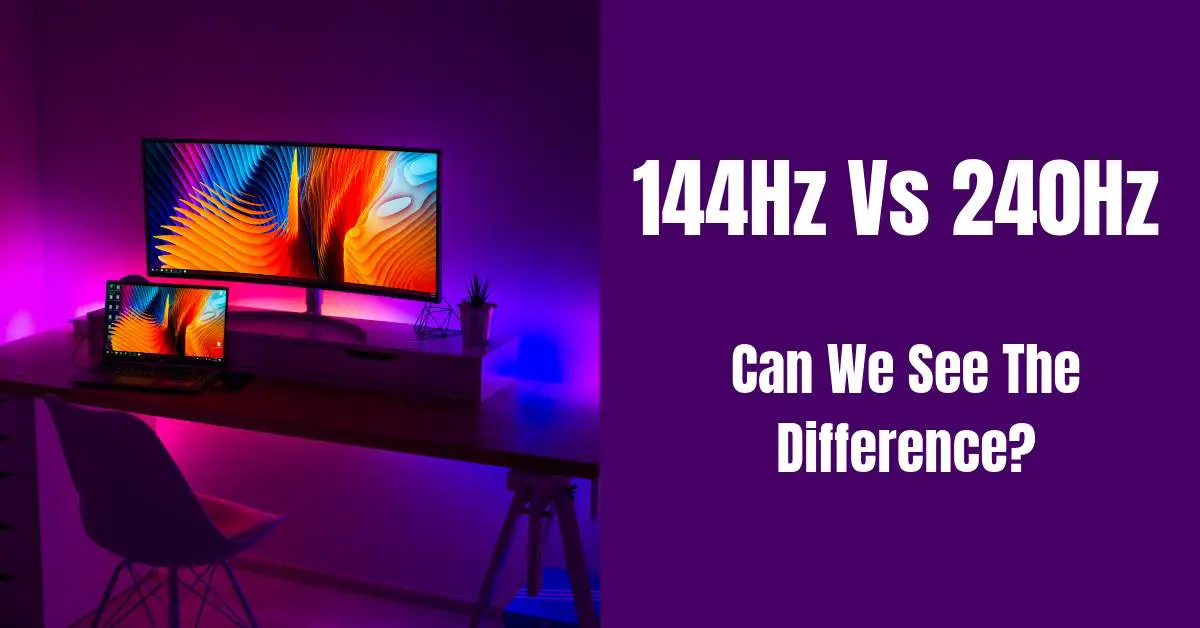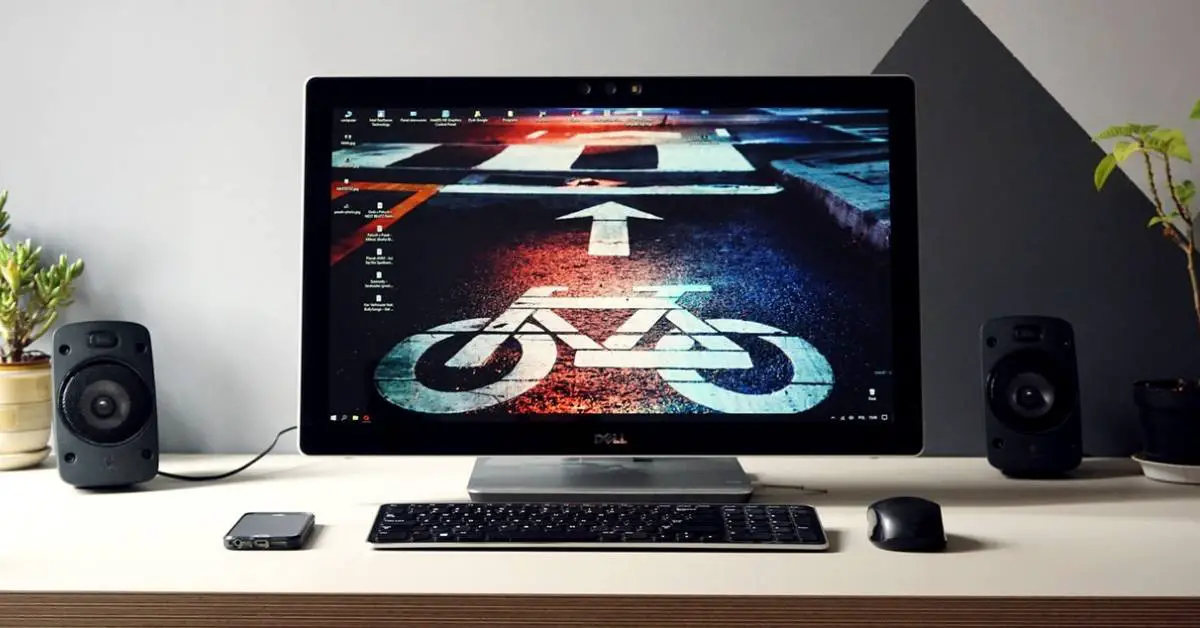If you’re a PC gamer like me, you know that having a high refresh rate monitor can make a big difference in how smooth and responsive your gameplay feels.
But with monitors now going up to 240Hz, you may be wondering whether it’s worth upgrading from your trusty 144Hz display.
In this article, I’ll compare 144Hz vs. 240Hz monitors to help you decide if the jump to 240Hz is worth it for your needs.
We’ll look at the key differences, pros and cons of each refresh rate, and whom a 240Hz monitor would benefit the most.
What is a Monitor’s Refresh Rate?
Before we dive into the 144Hz vs. 240Hz comparison, let’s briefly go over what a monitor’s refresh rate actually means.
The refresh rate determines how many times per second a monitor can refresh the image on the screen. It’s measured in Hertz (Hz).
- A 60Hz monitor refreshes its image 60 times per second
- A 144Hz monitor refreshes 144 times per second
- A 240Hz monitor refreshes 240 times per second
The higher the refresh rate, the more fluid and responsive the motion will look. It reduces motion blur and decreases input lag, which is great for fast-paced games.
Upgrading to a higher refresh rate monitor makes gameplay feel much smoother. Going from 60Hz to 144Hz is a very noticeable jump.
The difference between 144Hz and 240Hz is less dramatic but still beneficial for competitive gamers.
Now let’s look at the advantages and disadvantages of each refresh rate tier.
144Hz Monitor Benefits
For many gamers, a 144Hz monitor strikes the ideal balance between performance and price.
Here are some of the benefits of gaming at 144Hz:
- Super smooth gameplay – Going from a standard 60Hz monitor to 144Hz makes a huge difference in how fluid games look and feel. You’ll immediately notice reduced motion blur during fast movements.
- Great for high frame rates – To take full advantage of a 144Hz refresh rate, you’ll want a graphics card powerful enough to output 100+ fps consistently. This is achievable for many gamers.
- Excellent price-to-performance value – While more affordable than 240Hz monitors, today’s 144Hz models still offer premium gaming features like fast response times and low input lag. Popular 144Hz gaming monitors can be found for $150 to $250.
- Lower GPU requirements – Running games at 100+ fps is demanding, but usually manageable on mid-range to high-end GPUs. Going above 144 fps requires a more powerful graphics card.
For serious and competitive gamers who don’t need the absolute highest refresh rate, a 144Hz gaming monitor gives you an incredibly responsive experience for a reasonable price.
- 24" class, 23.6" viewable AOC Gaming monitor with 1920 x 1080 Full HD Resolution
- 1500R curved monitor wrapping around your vision for an immersive gaming experience. Purchase multiple C24G1As for an even more immersive battle station.
- Rapid 1ms (MPRT) response and now with 165Hz (via DP 1.2 port) refresh rate with AMD FreeSync Premium for smoothest competitive gameplay (48-165Hz LFC supported via DP)
Affiliate links: Clicking the device names, images or check price buttons will redirect you to the product listing on the appropriate Amazon.com (.co.uk, .de, etc.) / Image courtesy of Amazon
240Hz Monitor Benefits
240Hz monitors push refresh rates even higher for the ultimate competitive gaming experience.
Here’s what you gain by going up to 240Hz:
- Incredibly fluid motion – 240Hz makes high-motion games like competitive shooters feel extremely fluid and responsive. Motion blur is reduced to imperceptible levels.
- Faster response time – To fully take advantage of 240Hz, you need a monitor with a fast 1ms response time. This further reduces perceived motion blur and ghosting.
- Lower input lag – At 240Hz, input lag is reduced to around 4ms, compared to 6.94ms at 144Hz. Every millisecond counts during intense multiplayer matches!
- Higher frame rate potential – To see a visible benefit over 144Hz, you need a PC and GPU capable of outputting 200+ fps consistently. This is demanding but achievable with high-end setups.
- Future-proofing – As GPUs get more powerful, 240Hz gives you room to scale up frame rates for years to come without being limited by your monitor.
Overall, 240Hz gives you a slight competitive edge over 144Hz with its impeccable motion clarity and hyper-responsive feel.
It’s best suited for esports professionals and highly competitive players.
- 27" AOC Gaming G2 series monitor with 1920x1080 Full HD (1080P) Resolution Curved VA panel.Aspect ratio:16:9.Viewing Angle:170.0 degrees
- 240Hz refresh rate (via DP1.4) and rapid 0.5ms MPRT response time lets you target moving opponents with precision, putting you ahead of the game. Fast-moving action and dramatic transitions will be rendered smoothly without the effects of ghosting with AMD FreeSync Premium technology.
- 1500R curved monitor wraps around your vision for an immersive gaming experience
Affiliate links: Clicking the device names, images or check price buttons will redirect you to the product listing on the appropriate Amazon.com (.co.uk, .de, etc.) / Image courtesy of Amazon
Which is Better for Gaming – 144Hz or 240Hz?

So which refresh rate is better for gaming and provides the best experience? Here are some key considerations:
- For most gamers, 144Hz delivers an excellent blend of smoothness and value. Unless you’re a highly competitive player, 144Hz will give you a fantastic gaming experience.
- 240Hz is beneficial for competitive esports gamers who want every last bit of advantage. The differences vs. 144Hz are subtle but can matter at the pro level.
- To fully utilize 240Hz, you need a GPU and game engine capable of outputting 200+ fps consistently. This requires high-end hardware. With lower frame rates, 144Hz, and 240Hz look very similar.
- Both refresh rates require a monitor with fast response times (1 ms) to prevent motion blur and ghosting from negating the benefits.
- When choosing, consider your current PC hardware and the types of games you play. For competitive multiplayer games like CSGO or Valorant, 240Hz is great if you have the GPU to power it. For AAA games where achieving 200+ fps isn’t realistic, like Cyberpunk or Elden Ring, 144Hz will still provide an amazing experience.
Overall, I recommend 240Hz primarily for competitive esports gamers who have powerful hardware and want every tiny advantage they can get.
For most other gamers, 144Hz represents an awesome sweet spot where you still get buttery smooth motion and responsiveness at a more affordable price.
1080p vs 1440p High Refresh Rate Gaming
Another key consideration is whether you game at 1080p or 1440p resolution. Let’s compare them:
- 1080p – At 1920 x 1080 resolution, it’s realistic to achieve very high frame rates beyond 144 fps on mid-range and high-end GPUs. This makes a 240Hz refresh rate more beneficial. 1080p 240Hz monitors don’t cost too much more than 144Hz models.
- 1440p – At 2560 x 1440, frame rates will be lower than 1080p with the same GPU. It’s harder to surpass 144 fps at this resolution without a top-tier graphics card. Because of this, 144Hz makes more sense for 1440p gaming unless you have an incredibly powerful PC. 240Hz 1440p monitors are still quite expensive.
Based on your GPU power and chosen resolution, consider whether you’ll realistically be able to surpass 144 fps often enough to benefit from 240Hz.
For most people gaming at 1440p, a 144Hz refresh rate will still provide an amazing experience while letting you take advantage of the higher resolution.
Do You Need a 240Hz Monitor?
With the key differences covered, do you need a 240Hz gaming monitor? Here are some buying guidelines:
You should consider 240Hz if:
- You play competitive esports and want every tiny advantage
- You have a high-end GPU that can output 200+ fps
- You currently game on 1080p resolution
- You want extremely fluid motion clarity
- You can afford the $300+ price tag
Stick with 144Hz if:
- You mainly play AAA games where achieving 240+ fps isn’t realistic
- You have a mid-range GPU that won’t surpass 144 fps often
- You game at 1440p or 4K resolution
- You still have a 60Hz monitor and want a significant upgrade
- You want to save money and get great value
For most casual and mainstream gamers, I think a 144Hz monitor gives you an excellent balance of responsiveness and value.
But for competitive players who want that ultra-fluid 240Hz motion, and have the hardware to support it, an upgrade to 240Hz can be worthwhile.
Frequently Asked Questions
Q: How much more expensive are 240Hz monitors compared to 144Hz?
A: Expect to pay $100-150 more for a comparable 240Hz monitor over a similar 144Hz model. 240Hz 1080p monitors generally range from $250 to $400. Good 144Hz 1080p monitors are available between $150 and $250.
Q: If I don’t reach 240 fps, is 240Hz still worth it?
A: You can still benefit from 240Hz even below 240 fps. Input lag will be lower compared to 144Hz. However, to see a noticeable improvement in motion clarity and smoothness, you’ll want frame rates consistently over 144 fps. Below that, 144Hz and 240Hz will look very similar.
Q: I have a 60Hz monitor currently. Should I upgrade to 144Hz or 240Hz?
A: Upgrading from 60Hz to 144Hz is a huge leap in smoothness and responsiveness. Unless you are an extremely competitive esports gamer, I’d recommend upgrading to 144Hz first. It’s a more affordable jump that still offers a tremendous improvement over 60Hz.
Q: Is a 1ms response time necessary for 240Hz monitors?
A: For 240Hz gaming, you want a monitor with a 1ms (GTG) response time to get the full benefit. Slower response times will cause distracting ghosting and motion blur at 240Hz refresh rates. Aim for 1ms or better when buying a 240Hz gaming monitor.
Q: If I get 240+ fps, will a 240Hz monitor decrease input lag?
A: Yes, at the same frame rate, a 240Hz monitor will have lower input lag compared to 144Hz, typically around 4 ms vs. 6.94 ms. This reduced input lag can provide a competitive advantage.
MORE INFORMATION
If you enjoyed this 144Hz vs 240Hz comparison, you’ll probably like our other articles about monitors or gaming as well. Here are some popular resources from the Nechstar:
Credits: Photo by Alexandru Acea
Disclaimer: Our recommendations are honest and we are highlighting only products that are above average at the time of the review. Some of the links we add to this page are affiliate links. We may receive a small commission if the purchase is made through those links… this adds no additional cost to you.
Clicking the device names, images or check price buttons will redirect you to the product listing on the appropriate Amazon.com (.co.uk, .de, etc.), where you can find the updated prices, customer reviews, and more product details.




